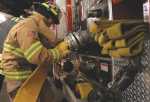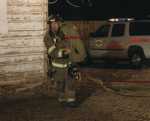Where there's smoke...

It took mere seconds for the fire to spill out of control. As blinding cloud of smoke filled the room, the flames rapidly flared upward and spilled out across the ceiling.
With the fire doubling in size every 30 seconds, it was already eating up all of the oxygen that was in the kitchen. It was only a matter of minutes, perhaps seconds, before it would kill anyone trapped inside.
But help was already on the way. Crawling on their hands and knees, a three-person crew from the Mountain Home Fire Department had made their way from the living room and down the hallway before they reached the kitchen where they fire had started.

The heavy stream of water from their hose hit its mark and quickly quelled the flames. Within a matter of minutes, the crew had the fire extinguished and were already on their way out of the home.
Stepping out into the icy evening air, the firefighters removed their helmets and pulled off their air masks, knowing they won this battle with a minimum of damage to the structure. After all, it was just an exercise.
Next time, however, they may not be so lucky.

Last Thursday, members of the Mountain Home Fire Department put their skills to the test during a live fire drill. Held in an abandoned home at 1145 American Legion Blvd., this hands-on exercise gave the firefighters "realistic, objective-based training" unavailable through other means, according to Mark Moore, a captain with the city fire department.
While the department has a fire training simulator, it does have limitations, according to Moore. For example, the house used in the exercise is much larger than the simulator and required crews to crawl through more places to get at the flames.
Thursday's fire also gave firefighters a first-hand look at how fire behaves in an actual structure where the conditions are not easily controlled. At the same time, it reached more realistic temperatures -- a blistering 1,200 degrees Fahrenheit.
It's this fact the prompted the department's firefighters and support vehicles to remained on scene to keep the situation under control.
Meanwhile, senior fire fighters like Rick Van Meer were strategically located inside the home to keep the flames from reaching "critical mass," Moore said. They would spray water on the advancing fire as needed to keep it contained to the one room.
The initial live fire exercise was one of four scenarios planned during the evening. The remaining training included what Moore called "cold smoke fires."
Generators stationed outside pumped realistic-looking smoke into the house, reducing visibility to next to zero. It prompted the fire crews to rely on their instincts and training to reach their objectives, which included sweeping the home for possible victims lying unconscious on the floor.
Throughout the evening, the training focused heavily on safety. It was already stressed in the days prior to the exercise and repeated again by firefighter Chuck Van Meer as the crews suited up.
There's a reason why safety is so paramount, even during training, according to Moore. In 1982, two firefighters died during a live fire exercise. It prompted a significant revision to national fire training standards, which are reviewed and revised every five years.
What came out of those revisions was a training curriculum that continues to train crews under very realistic conditions while ensuring every step is taken to keep them safe.
It's a "very controlled deal," Moore said.
After each training session, the fire crews needed to get checked out by the ambulance crew strictly as a precaution. And that's not an option, he added.
Dave Harris, who joined the department 30 years ago, has seen firsthand how the department's level of training has evolved.
"It's much better now; much more involved and organized," he said.
The training curriculum today goes into far more detail, from outlining the roles of the safety officers overseeing the crews to the rapid intervention teams that will actually enter the burning structure, Harris added.
Bret Young is one of the department's four "probies" -- department slang for probationary firefighter. For the past five months, he's been part of the department's chaser program, which has allowed him to ride along with the firefighters
While he's seen his fair share of actual fires, Young knows he's still a long way from being one of the people that will enter a burning structure. However, he and the other probies were allowed to suit up and enter the building during the cold smoke training.
At the same time, Young was moved up to helping run the pumper trucks that supplied water to the crews venturing inside the burning structure earlier that night. This certification was just the beginning of an extensive training program that will turn Young and the department's other probies into full-fledged firefighters.
With the list of available homes in Mountain Home to conduct this type of training in short supply, Moore hopes to squeeze another three months worth of training out of the structure before the department allows it to fully burn for one final exercise.
"We do not want to burn this house down tonight," Moore stressed to his firefighters prior to last week's training.
The selection of houses for these exercises requires a considerable amount of homework, according to Moore. In addition to removing asbestos out of the walls and ceiling, which is often present in older homes, they can't have any significant structural damage.
Holes in the walls and ceiling are particularly bad since they give flames places to escape and spread through the rest of the home, according to Moore. When possible, those outlets are patched up.
When a home fits the department's needs, it can still take months to gain the necessary clearances before they schedule any training. In addition to getting written permission from the home's owner, the city needs to verify ownership of the building while ensuring the title is properly transferred.
"If we can get one house a year, that would be ideal," the fire department captain said.
But as the live-fire training continues, the fire captain knows there will be limitations. For example, the sheet rock on the walls and ceiling in one room were likely weakened after they were hit by water during a previous training exercise and could eventually collapse.
It's just one more thing these firefighters will have to remember when they have to fight a fire for real.
